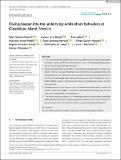Files in this item
Diving deeper into the underlying white shark behaviors at Guadalupe Island, Mexico
Item metadata
| dc.contributor.author | Aquino-Baleytó, Marc | |
| dc.contributor.author | Leos-Barajas, Vianey | |
| dc.contributor.author | Adam, Timo | |
| dc.contributor.author | Hoyos-Padilla, Mauricio | |
| dc.contributor.author | Santana-Morales, Omar | |
| dc.contributor.author | Galván-Magaña, Felipe | |
| dc.contributor.author | González-Armas, Rogelio | |
| dc.contributor.author | Lowe, Christopher G. | |
| dc.contributor.author | Ketchum, James T. | |
| dc.contributor.author | Villalobos, Héctor | |
| dc.date.accessioned | 2021-10-20T12:30:05Z | |
| dc.date.available | 2021-10-20T12:30:05Z | |
| dc.date.issued | 2021-10-18 | |
| dc.identifier | 276355772 | |
| dc.identifier | 7dd1ba71-f5ee-4bf7-be4a-6179527cf346 | |
| dc.identifier | 85117065624 | |
| dc.identifier | 000707924600001 | |
| dc.identifier.citation | Aquino-Baleytó , M , Leos-Barajas , V , Adam , T , Hoyos-Padilla , M , Santana-Morales , O , Galván-Magaña , F , González-Armas , R , Lowe , C G , Ketchum , J T & Villalobos , H 2021 , ' Diving deeper into the underlying white shark behaviors at Guadalupe Island, Mexico ' , Ecology and Evolution , vol. Early View , 8178 . https://doi.org/10.1002/ece3.8178 | en |
| dc.identifier.issn | 2045-7758 | |
| dc.identifier.other | RIS: urn:F7C3A0C49575882B41ABC157C1F9E491 | |
| dc.identifier.uri | https://hdl.handle.net/10023/24174 | |
| dc.description | We thank grants and logistic support from Alianza WWF-Fundación Carlos Slim, Alianza WWF-Telcel, Annenberg Foundation, Pfleger Institute of Environmental Research (PIER), and Fundación Mundo Azul. HV, FGM, and RGA acknowledge support from SNI (CONACYT), and COFAA and EDI programs from Instituto Politécnico Nacional. | en |
| dc.description.abstract | Fine-scale movement patterns are driven by both biotic (hunting, physiological needs) and abiotic (environmental conditions) factors. The energy balance governs all movement-related strategic decisions. Marine environments can be better understood by considering the vertical component. From 24 acoustic trackings of 10 white sharks in Guadalupe Island, this study linked, for the first time, horizontal and vertical movement data and inferred six different behavioral states along with movement states, through the use of hidden Markov models, which allowed to draw a comprehensive picture of white shark behavior. Traveling was the most frequent state of behavior for white sharks, carried out mainly at night and twilight. In contrast, area-restricted searching was the least used, occurring primarily in daylight hours. Time of day, distance to shore, total shark length, and, to a lesser extent, tide phase affected behavioral states. Chumming activity reversed, in the short term and in a nonpermanent way, the behavioral pattern to a general diel vertical pattern. | |
| dc.format.extent | 18 | |
| dc.format.extent | 1987579 | |
| dc.language.iso | eng | |
| dc.relation.ispartof | Ecology and Evolution | en |
| dc.subject | Bayesian inference | en |
| dc.subject | Behavioral states | en |
| dc.subject | Energy costs | en |
| dc.subject | Movement strategies | en |
| dc.subject | Telemetry | en |
| dc.subject | GC Oceanography | en |
| dc.subject | QA Mathematics | en |
| dc.subject | DAS | en |
| dc.subject | SDG 14 - Life Below Water | en |
| dc.subject.lcc | GC | en |
| dc.subject.lcc | QA | en |
| dc.title | Diving deeper into the underlying white shark behaviors at Guadalupe Island, Mexico | en |
| dc.type | Journal article | en |
| dc.contributor.institution | University of St Andrews. Statistics | en |
| dc.identifier.doi | 10.1002/ece3.8178 | |
| dc.description.status | Peer reviewed | en |
| dc.identifier.url | https://onlinelibrary.wiley.com/doi/10.1002/ece3.8178 | en |
This item appears in the following Collection(s)
Items in the St Andrews Research Repository are protected by copyright, with all rights reserved, unless otherwise indicated.

